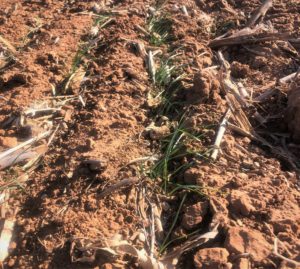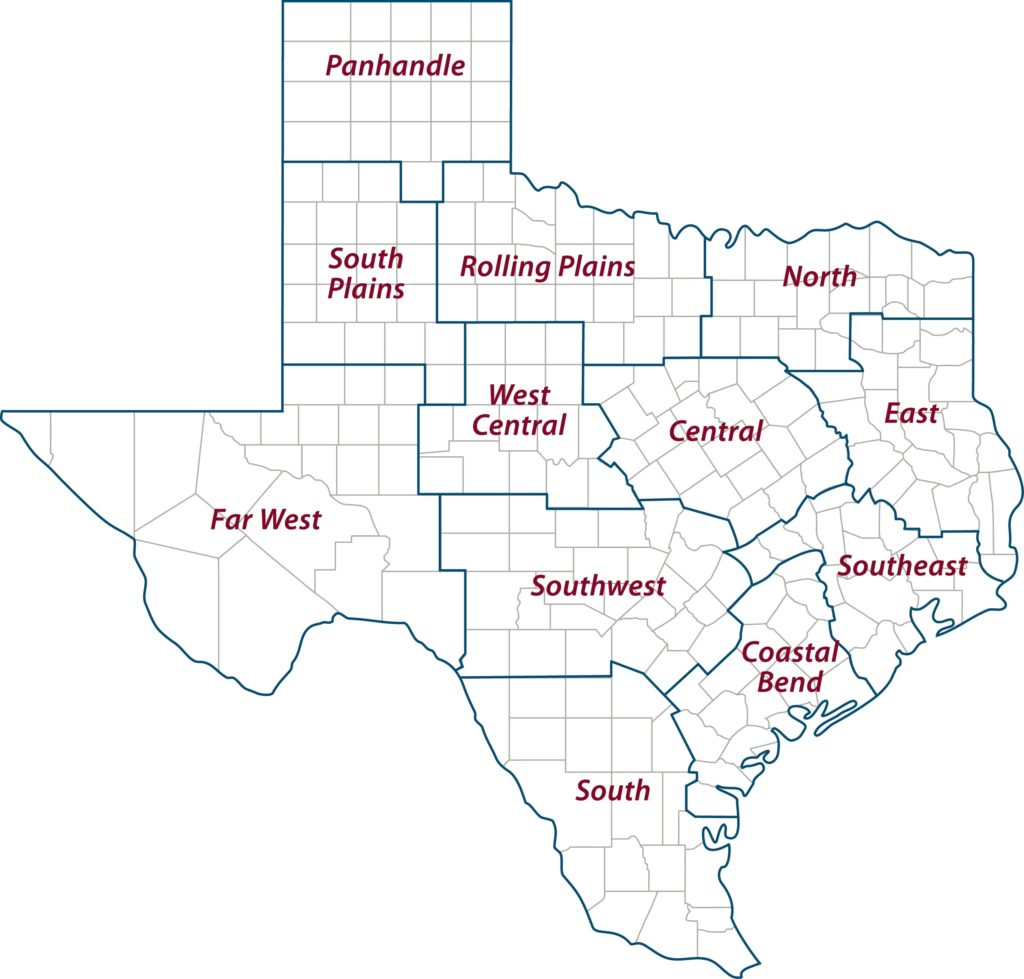Panhandle wheat at critical phase amid drought
Texas Crop and Weather Report – Feb. 9, 2021
Texas wheat acres in the Panhandle are at a crossroads due to drought.
Timely rains could allow the crop to provide needed forage for the region’s beef and dairy producers or make it to grain. But if rains don’t materialize, 2021 will be a below-average season for most irrigated wheat acres and worse for dryland fields.

Jourdan Bell, Ph.D., Texas A&M AgriLife Extension Service agronomist, Amarillo, said wheat conditions across the Panhandle were poor to average depending on location. Precipitation amounts, especially for dryland fields, were the primary factor contributing to wheat performance.
“Conditions vary across the region, but drought levels are the story,” she said. “To the west and southwest, conditions are poor, and fields improve as you move east and especially northeast. Most of the region didn’t pick up the typical August, early September rains during monsoon season, so there was no buildup of a good soil moisture profile to carry the wheat crop through dry winter months.”
Wheat performance in the northeast corner and eastern parts of the Panhandle were linked to those fields catching those late summer rains, she said.
Bell said the Texas A&M AgriLife station in Bushland reported just 1.5 inches of rain since Oct. 1. Although parts of the region received some precipitation via snowfall, this year’s snowfall has been below average, and the snowfall received has not helped the soil moisture profile due to above-average temperatures and high winds that quickly dried out the soil.
“We’ve had several inches of snowfall, but it hasn’t been a significant help, and we have had rain in some areas, but it was followed by 40-50 mph winds, so it hasn’t been very beneficial,” she said. “Drought has persisted, and drought conditions are spreading into those northern counties.”
Wheat struggling amid drought
Bell said producers used the Panhandle’s broad planting window – late-August and early September for grazing and up to early December for grain production – to get acres in. But many acres had to be “dusted in,” or drilled into dry soil, with the expectation that it would rain or snow. At this point, producers are pulling cattle from fields that have run out of forage. The move by cattle producers is earlier than usual and indicative of poor crop conditions.
Bell said the rest of the growing season will depend on timely rains.
“Even though conditions are poor, wheat is resilient, and if we do pick up rains, it will bounce back. Even though we will be too late for winter grazing, we still have an opportunity for spring silage or hay and grain production,” she said. “Wheat is an increasingly important silage crop in the region because of the expanding dairy herds.”
Poor production as a silage crop could force dairy producers to reevaluate their forage rations and look to incorporate other crops, Bell said. Silage is an expensive crop to transport because it is a wet forage, and water weight adds to freight costs.
However, grain production may be the preferred end-game option for wheat producers because prices improved significantly over recent years, she said. The next few weeks will be critical for grain yield potential.
Bell said stands are normally transitioning from vegetative development to reproductive development in late February to early March, and continued drought could translate into fewer seeds per head and below-average yields.
“Producers with irrigation are making decisions about inputs (irrigation and fertilization) as well as deciding to harvest for grain or silage or graze out this year’s crop,” she said. “Current grain prices are favorable so many irrigated producers are leaning to grain production. But dryland producers are at the mercy of Mother Nature.”
AgriLife Extension district reporters compiled the following summaries:

CENTRAL
Temperatures were above normal before a front brought cooler temperatures and some rainfall. Corn producers were preparing soil to plant. Small-grains fields received fertilizer top dressing. Farmers were behind schedule on preparing fields for spring planting due to soggy soils, but some were moving back into fields. Livestock were in good to fair condition with heavy supplemental feeding. More cattle were being grazed on winter forages. Topsoil moisture was adequate for planting. Winter wheat was developing very well under cool, wet weather; however some fields were requiring an herbicide spray to cut heavy weed competition from ryegrass and henbit.
ROLLING PLAINS
Winter wheat fields continued to improve with conditions ranging from poor to fair. Cattle producers continued providing protein supplements and hay where forages were limited.
COASTAL BEND
Dry conditions allowed row crop and rice producers to resume fieldwork, including bed preparation, weed control and fertilization. Some corn acres were planted. Some early varieties of fruit trees began to bloom. Warm days helped promote winter pasture growth, however, winter pastures performed below average this season. Livestock were doing well as producers continued to feed hay and protein.
EAST
Temperatures were warmer with high winds. Some areas received a little rainfall. Smith County reported the need for more rain. Panola County reported winter forages continued to struggle due to dry conditions and were not expected to rebound for spring. Pasture and rangeland conditions were poor to fair. Subsoil and topsoil conditions were adequate. Cattle prices were up in all classes. Livestock were fair to good with supplemental feeding taking place. Feral hogs were a problem for most producers.
SOUTH PLAINS
Dry conditions continued across the district. The majority of dryland winter wheat was in poor condition. Much of the winter wheat had not emerged due to the lack of moisture. Cattle producers were relying on supplemental feeding due to the poor wheat grazing, and pasture grazing was basically nonexistent.
PANHANDLE
Conditions continued to dry. Northeastern parts of the district reported very short topsoil and subsoil moisture with northwestern areas reported adequate to short soil moisture and other areas reporting short to very short conditions. Pasture and rangeland conditions were poor to very poor. Winter wheat fields were in poor to good condition. Dryland winter wheat was suffering due to lack of moisture, germination was sporadic in many areas. Oat field conditions were fair. Cattle diets were being supplemented on rangelands and winter pastures.
NORTH
Topsoil moisture throughout the district was adequate to short. Weather was mild. Temperatures stayed above average until a front delivered cooler temperatures. An arctic front was in the forecast with temperatures expected to enter the teens this week. Winter wheat was doing well in some areas but looked poor in other areas. Ryegrass should start growing soon with milder weather and recent rains. Livestock were doing well and in good condition. Spring calving season was underway. Early planted wheat and oats were being grazed, and late-planted winter pastures were progressing slowly but should start producing well as temperatures warm. Feral hog signs and sightings continued to be high.
FAR WEST
Daytime temperature highs were in the upper-70s with lows in the mid-30s overnight. Trace amounts of rain were reported. Livestock were in overall good condition, but many ranches were culling deep to save resources. Extremely high winds dried the topsoil out quite a bit. There was a considerable amount of blowing dirt despite grower efforts to prevent erosion. Most wheat planted in November and December had emerged, but growth was slowing, and fields were in poor to fair condition due to the lack of moisture. Wheat fields may not make grain without significant rain. Growers were performing some fieldwork before remaining moisture was gone. There was limited vegetation and forage growth on rangelands.
WEST CENTRAL
Temperatures were above average. Cool-season grass growth was good. Winter wheat fields were in mostly good to excellent condition. Winter dormancy was beginning to break in some areas, with wheat showing signs of early spring growth. Some producers applied herbicides for weed control. Other fieldwork was being done for spring-planted crops as well. Rangeland and pasture conditions were mostly good. Livestock were in good shape. Livestock producers continued supplemental feeding across the district.
SOUTHEAST
Soil conditions were drying somewhat. Small grain forages were maintaining quality, and emergence was nearing for early spring producing varieties. Gardeners were preparing soil for spring planting. Colder temperatures were expected to increase hay fed to livestock. Rangeland and pasture ratings were excellent to very poor with fair ratings being the most common. Soil moisture levels ranged from adequate to surplus with adequate levels being the most common.
SOUTHWEST
Temperatures were warmer with little to no rain across the district. Rangeland and pasture conditions were declining with the lack of moisture. Field preparation continued for row crops, and a few home gardeners were getting started. Kinney County reported that irrigated oat and wheat fields were in good condition. Caldwell County reported sheep and goat prices were higher while cattle prices were lower. Livestock were in fair to good condition with continued supplemental feeding. Producers were shipping in hay from further distances.
SOUTH
Soil moisture levels were adequate to very short depending on location, but drought conditions were spreading. Temperatures were mild with light rainfall in Frio County, and Cameron County reported some drizzle but no accumulation. A strong cold front was in the forecast. Pasture and rangeland conditions were improving in wetter areas. Beef cattle conditions were fair, and most producers were supplementing with hay and protein. Hay producers were selling hay for $50 -$65 per round bale. Irrigated winter forages were performing well under warmer temperatures. Local auctions reported lower sale volumes and higher prices. Row crop farmers were busy fertilizing and preparing for planting. Many areas needed additional rainfall before planting. Deer breeders were supplementing diets with cottonseed, protein, corn and alfalfa hay. Oat pastures were not developing well due to the lack of rainfall. Coastal Bermuda grass fields were still dormant. Producers in Hidalgo County were pre-watering fields expected to be planted in sorghum, corn and cotton, and some were already planting sorghum and corn. Winter vegetables looked good and were being harvested. Citrus and sugarcane harvests continued. Willacy County reported the growth of small root vegetables. Crop fields were irrigated heavily.


